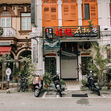Townscape and the Design of Cities
- Shuhana Shamsuddin

- Sep 6, 2020
- 4 min read

Townscape to the urban designers is like building to the architect, a city to the planners or a park to the landscape architect. It is where one can appreciate the success of design coordination in a town or city. When Gordon Cullen wrote his book "The Concise Townscape" in the sixties, he was actually celebrating the glory of the medieval cities in Britain which was a stark contrast to the bland modernist townscape of postwar Britain. It was an eye-opening book that illustrates the vanishing glorified townscape which he described as the art of relationship that involved the vision, juxtaposition and the content of the fabric that make up a city.
Imagine a town as a good book. the ability to immerse oneself in its writing. and good urban design of the town will ensure that users will enjoy the town just like a reader enjoying a good book. A good townscape does not happen by chance but requires careful thought given to the coordination of all the elements that make up a city and the story that the city is telling to its visitors. Townscape is the outcome of the decisions made by many, from the politicians, the professionals working in the local authorities, developers, architects to the general public. The townscape quality is the result of the coordination done at the local authority level which controls and guides the design that is produced within the city. When the townscape is haphazard and cluttered then it implies such coordination does not take place and each building that appears will be produced without due consideration to its effect to the immediate or neighbouring buildings.
The principle of ‘keeping in keeping’ that was applied when assessing new development within existing city centres in the UK has ensured that only buildings that are responding to their context will be given planning permission.

Photo 1: Back in 1905, Arthur Benson Hubback implemented a form of building design regulation for shophouses in Kuala Lumpur resulting in a cohesive look that gives the whole area a sense of identity. There are few to no reason why such practice should not be carried out today to achieve a similar townscape quality.
Crucial to the storytelling of the townscape is the climax of the story which usually focuses on the centre. The centre of a city from an urban design perspective does not necessarily correlate with the centre from town planning perspectives.
In urban design, a centre is a place of meanings ie the face of the city that reflects its identity. This usually involves places of historical significance or iconic places that people are attached to. The clever interplay between the centre and the other parts of the city and the design of the streets that provide the linkages between these places will result in a townscape with identity.

Photo 2: Although providing a good public transport network is crucial in connecting the city, the placement of this station robs such a historically significant building such as the Masjid Jamek of its prominence within the townscape.
In Malaysia, very few cities have a townscape quality worth shouting about except for the two cities George Town and Melaka that were jointly designated as UNESCO World Heritage Sites. Even these two places are now under threat from the surrounding development that is not sensitive to the historical context and townscape qualities. These two sites’ townscape qualities are reminiscent of the medieval townscapes of Europe where one can observe the artistic quality of the facade design, street design and the juxtaposition of buildings that creates interesting urban spaces.

Photo 3: One of few juxtapositions located at the Old Market Square in Lebuh Pasar ties the urban space together and contribute to the overall image and character of the place.
One of the glaring problems of our townscape is the cluttered street frontage that is filled with fascia boards, billboards and signages that tend to screen the building facades. In cases where the facade has an aesthetic value, such act of disrespect to the building design will result in the building not contributing to the streetscape. In the case of the modern shop house or shop office, it justifies the lack of efforts given by the architect to design an interesting facade in anticipation that the facade will be screened by advertising boards once the tenants start to operate their businesses. facade in anticipation that the facade will be screened by advertising boards once the tenants start to operate their businesses.

Photo 4: Apart from signages and billboards covering shopfronts, here we can see an attempt to beautify the streetscape backfires as it obscures the unique features of the shophouse’s façade. This results in the mediocrity of the streets’ design as the viewers could not appreciate the architecture of the buildings along the street. The situation is worse if it involves the high street. The question raised here is why is there a lack of control in the design of buildings in the city centre. Whilst there is some interesting architecture of individual buildings in the city, they are designed as an individual and not as part of a group. It is like a party with so many beautiful people but they don’t talk to each other.
It is time that local authorities do their housekeeping and coordinate the development in terms of design so that we can have a city with identity and respecting its genius loci in retaining its sense of place. Apart from stringent design control during application of planning permission (kebenaran merancang), guidance towards the type of design that the local authority would like to see in their city should also be given to the architect and developers.
It is also important for local authorities to conduct a townscape appraisal of all sites within the city centre and other important sites in order to establish the character that needs to be respected so that new buildings and the existing ones can exist like an ensemble. This appraisal should be included in the report (LCP) submitted for planning permission to show how the new design is responding to its immediate context.
It is hoped that the unique townscape of our existing cities can be protected and the townscape of the proposed new development will have a significant contribution to the identity of the city in the future. Figure & Captions: Siti Marsitah Rosly











Comments